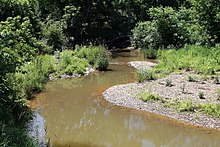Mud Run (Green Creek)
| Mud Run | |
|---|---|

Mud Run from Utt Road
|
|
| Etymology | named for its |
| Basin features | |
| Main source | Greenwood Township, Columbia County, Pennsylvania |
| River mouth | Green Creek in Greenwood Township, Columbia County, Pennsylvania 600 ft (180 m) 41°07′05″N 76°25′33″W / 41.1180°N 76.4257°WCoordinates: 41°07′05″N 76°25′33″W / 41.1180°N 76.4257°W |
| Progression | Green Creek → Fishing Creek → Susquehanna River → Chesapeake Bay |
| Basin size | 13.3 sq mi (34 km2) |
| Tributaries |
|
| Physical characteristics | |
| Length | 5.7 mi (9.2 km) |
Mud Run is a tributary of Green Creek in Columbia County, Pennsylvania, in the United States. It is 5.7 miles (9.2 km) long and flows through Greenwood Township. The stream's watershed has an area of 13.3 square miles and is located in Greenwood Township, Orange Township, and Mount Pleasant Township. The stream is in the ridge and valley physiographic province. Its annual load of sediment is 4,394,600 pounds (1,993,400 kg). The Kramer Covered Bridge crosses the stream.
Mud Run begins in Greenwood Township on the western side of Bunker Hill. It flows south at first and after a short distance crosses Pennsylvania Route 254. The stream then turns southeast and flows into the Greenwood Valley. It then turns east and flows parallel to the southern edge of the valley for a number of miles, receiving several unnamed tributaries on the way. Near its mouth, the stream bends southeast and flows into Green Creek at the border between Greenwood Township and Orange Township.
The daily load of sediment in Mud Run is 12,040 pounds (5,460 kg) per day, which equates to a load of 4,394,600 pounds (1,993,400 kg) per year. The total maximum daily load for sediment in the stream is 3,524,315 pounds (1,598,602 kg). The sediment loads are not significantly affected by the area's geology.
Croplands are the largest source of sediment in the Mud Run watershed, contributing 3,299,200 pounds (1,496,500 kg) per year. 453,800 pounds (205,800 kg) of sediment comes from stream banks annually, 255,000 pounds (116,000 kg) comes from hay and pastures, 218,600 pounds (99,200 kg) comes from land classified as "transition" by the Pennsylvania Department of Environmental Protection. 137,800 pounds (62,500 kg) of sediment comes from forests and land considered by the Pennsylvania Department of Environmental Protection to be "low-intensity development" contribute 37,200 pounds (16,900 kg) of sediment to the stream per year.
The entirety of Mud Run and all its tributaries are considered by the Pennsylvania Department of Environmental Protection to be impaired, with the exception of the streams in the watershed of Mud Run's final tributary.
...
Wikipedia
